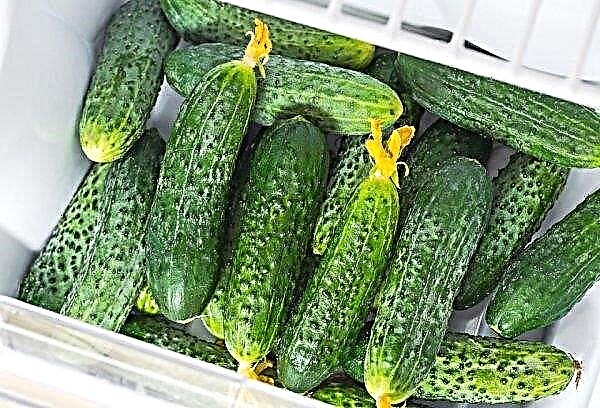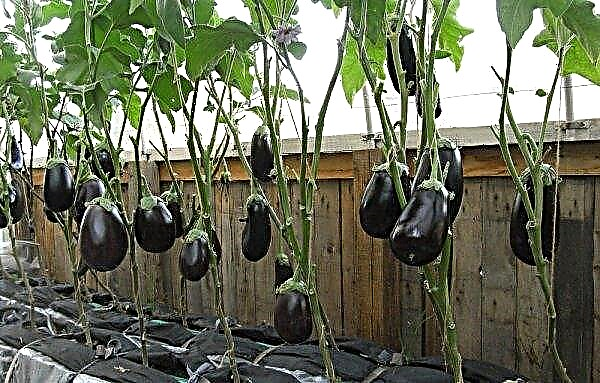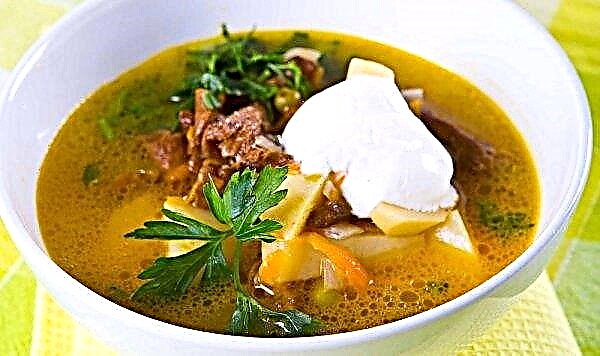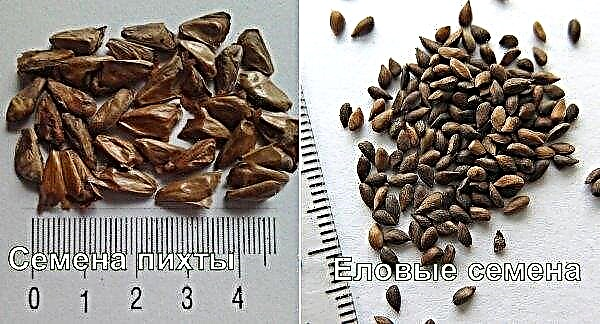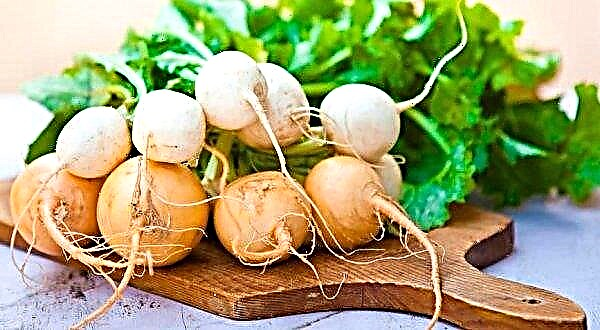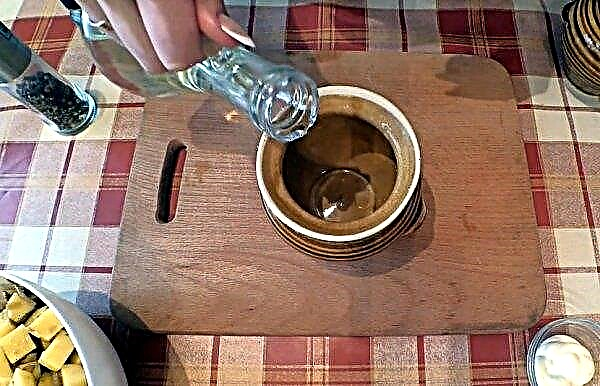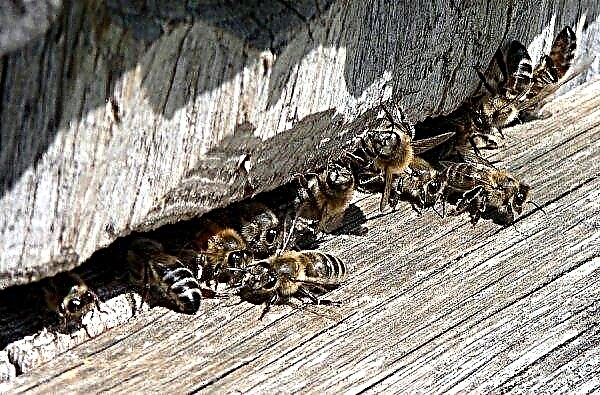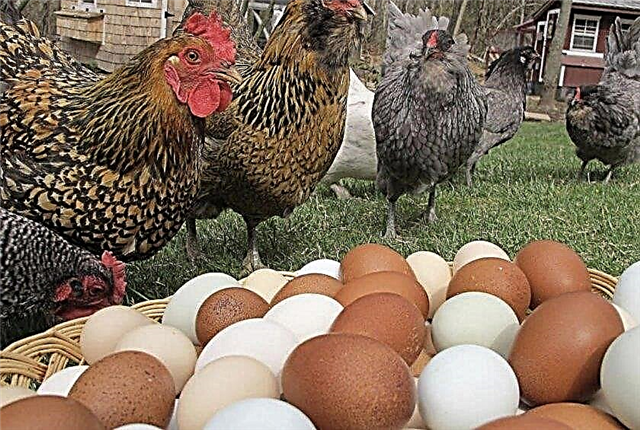Honeysuckle is a shrub with a specific taste of berries. It can be seen more and more often in garden plots, since it is not fastidious in care and gives a good harvest, for which it received positive reviews from many gardeners. To date, more than 200 varieties of this plant are known. This review talks about the main qualities of the Bakcharskaya variety and how to breed it.
Description of honeysuckle variety Bakcharskaya
Bakcharskaya honeysuckle bred in the northern region. This has contributed to the fact that the bush of such a plant is able to survive and give a quality crop in harsh climatic conditions.
Did you know? Under optimal conditions, honeysuckle bushes can bear fruit up to 120 years.
Selection history
Variety Bakcharskaya was bred by selection in the Bakcharsky stronghold of northern horticulture, now FSUE Bakcharsky (village Bakchar, Tomsk Region). Appeared in the State Register of Breeding Achievements of Russia in 1987. It should not be confused with the variety Bakcharskaya jubilee, which belongs to the second, later generation of honeysuckle from Bakchar.
Appearance, characteristics of berries, ripening time, yield
This variety has the following characteristics:
- medium-sized shrub up to 1.5 m high, with loose spreading semicircular crown 1.2–1.4 m in diameter;
- strong-growing branches, straight; one-year stems are light green in color, and fruit-bearing branches are thick, brown (anthocyanin) in color;
- leaves are gray-green, long, rounded, with villi on the surface;
- rather large flowers, they are located in pairs at the corners of the leaves and at the ends of the branches.
The fruits of this variety have the following characteristics:
- berries are large, weighing 0.8–1 g, diameter 2–2.3 cm, purple;
- the skin is durable, medium thickness, with a wax coating;
- the pulp is juicy, elastic, sweet and sour taste, food grade 4.5 out of 5;
- ripening medium-late berries, coming at the end of June;
- the yield is about 2–3.5 kg of fruit from one bush.
Features of the composition:
- fruits contain vitamins - A, B1, B2, C, K, PP;
- macro- and microelements - potassium, calcium, sodium, magnesium, phosphorus, iodine, copper, iron;
- organic acids - succinic, malic, citric, oxalic;
- still in the pulp there are sucrose, glucose, fructose, responsible for the sweetness of berries, flavonoids, antioxidants, tannins and pectin compounds.

Advantages and disadvantages of the variety
- This variety has the following advantages:
- high frost resistance (the root system can withstand -40 ° C, and shoots up to -50 ° C);
- immune to diseases and exposure to harmful insects;
- large-fruited;
- does not crumble;
- fruiting occurs in the second year after planting, with each subsequent year the yield increases;
- on average, 2-3 kg of berries can be picked from the bush, and with proper care and optimal climatic conditions (enough light and moisture), the yield increases to 3.5–4 kg;
- full productivity lasts about 20 years;
- have good transportability, easily carry transportation up to 300 km;
- berries contain a high amount of vitamins and nutrients;
- leaves and flowers have antimicrobial, antiseptic properties;
- fruits are widely used not only in cooking, but also in traditional medicine.
- Despite all the advantages, the variety has the following disadvantages:
- poorly tolerates places with wet soil;
- self-fertile, for a good harvest needs pollinators;
- in the dry season, without proper watering, the berries may be slightly bitter.
Agricultural technology
The rules of agricultural technology include - the correct choice of the site, the features of planting seedlings in a permanent place, further care of plants, pollination, the fight against ailments and harmful insects, crown formation, preparation for wintering.
Important! It is better to buy seedlings two-year-old, with a closed root system (in pots or containers) and only from trusted suppliers with the proper certificates. If the plant has an open root system (ACS), it is necessary to take all measures to prevent drying of the roots (it is best to wrap it with a damp cloth and place in a plastic bag).
Seat selection
When searching for the territory for planting honeysuckle culture, one should take into account such factors:
- the place must be chosen flat or with a slight slope, well-lit and protected from strong winds;
- the soil is cleared of weeds and grass;
- soil with moderate humidity and groundwater not higher than 1.5–2 m from the surface of the ridge;
- the plant prefers loam with neutral acidity, but can grow on soils other than the structure, except for sandy ones.
 The root neck of the seedling should be in the ground at a depth of not more than 5 cm.
The root neck of the seedling should be in the ground at a depth of not more than 5 cm.Landing and care
The best time for planting seedlings is autumn or early spring before the onset of the vegetative period. And before that, you need to prepare the landing site, in this way:
- Remove weeds with roots, dig up the ground. You can dig holes in advance (for 3-4 days, then the soil will settle down well), their size is 40 cm in diameter and 40 cm deep, add fertile soil (rotted compost, about 10 kg). The distance between rows is 2.5–3.5 m, and between the holes is 1.5–2 m.
- On the day of planting, pour superphosphate (40 g), wood ash (300 g).
- Lower the seedling into a pit, sprinkle with earth, lightly tamp and pour over water (10-12 l).
- For three years, drug fertilizers are not applied, you just need to fertilize the soil under the bushes with organic matter (in dry form or with a 2:10 solution). After the specified time, chemicals (potassium sulfate 25 g and double superphosphate 50 g) are introduced by dispersion, while the earth must be dug up.
- Top dressing should be carried out in several stages; the first time - when the plant blooms and the fruits begin to set, the second - when the crop ripens. The plant must be watered two to three times a week (especially if the season turned out to be arid, in other cases, if necessary, during flowering, ovary and ripening of the fruit). 10 l of water is enough for one bush.
- In addition, it is necessary to carry out preventive work, weed, plow the ground, examine the honeysuckle for the presence of harmful insects and symptoms of diseases.

Pollination Features
This variety is self-fertile, in order to get a good harvest, it needs pollinators (bees, bumblebees). Also, fruiting increases significantly if honeysuckle shrubs with the same flowering and ripening time grow nearby. It can be varieties Amphora, Lazurnaya, Nymph, Pavlovskaya, In memory of Gidzyuk.
Pest and Disease Control
The Bakcharskaya variety is immune to diseases and pests, but there is still the possibility of infection and attacks of harmful insects:
- Powdery mildew - a fungal disease, it manifests itself as a white coating on the foliage. After the fungus spreads throughout the bush, and high humidity contributes to its development. It is necessary to fight this ailment with the help of the preparations "Cumulus", "Rovral". Folk remedies: 1% Bordeaux liquid, copper sulfate.
- Tuberculosis - infectious fungal disease. It appears brown or reddish tuberous spots on the trunk of the plant. Mostly young shoots and annual growths are affected, if the disease is neglected, the bush dies (dries). To combat this infection, you can use solutions of the preparations "Khometsin", "Topsina M"; Affected branches should be cut to the root and burn.
- Aphids - small insects, body length 2 mm, light green. They have strong proboscis by which the leaves and young stems are pierced by eating their juice. As a result, they release a liquid that attracts other pests. They are also carriers of infections. Attack in large colonies. Larvae are laid on the leaves and shoots of the plant. You can deal with these pests with the help of “Aktara”, “Fitoverm”, “Iskra”, “Tanrek” preparations.
 In order to preserve the bush and get a good harvest, timely preventive work must be done: weed, dig up the soil, remove damaged branches and leaves.
In order to preserve the bush and get a good harvest, timely preventive work must be done: weed, dig up the soil, remove damaged branches and leaves.
Cropping and shaping the crown
For several years, the shrub gives a good growth of shoots, which leads to its thickening. In this regard, the light does not penetrate deep into the bush, the yield decreases, the berries lose their presentation and become tasteless, diseases develop. To avoid these undesirable consequences, it is necessary to trim and shape the crown every fall in this way:
- cut dry, broken, damaged by diseases or pests shoots;
- fruiting branches that are more than 10 years old, cut off at the base, without leaving stumps;
- unproductive stems can also be removed;
- shorten healthy strong shoots by one third.

Wintering
Another feature that distinguishes the Bakcharskaya variety is its frost resistance, so the shrub does not require shelter for the winter. You just need to remove the fallen leaves from under the bush, weed and weed along with the roots, dig the soil. The root system can be covered with mulch (straw, hay, sawdust) or rotted compost. Also, for prevention, it is advisable to spray the plant with a solution of 1% Bordeaux fluid.
Did you know? Many types of honeysuckle are decorative; their berries are red and yellow, they contain toxic substances that are dangerous to the human body. And varieties with blue and purple fruits are edible, they are used in cooking and medicine.
Harvesting and transportation of the crop, shelf life of berries
Due to the fact that the berries have a dense peel and hold well on branches, it is very convenient to collect them. Harvesting is better in dry weather, folding in small baskets. Also, honeysuckle tolerates transportation well, without losing its appearance.
 You can store the fruits fresh for 5–7 days in a dark, dry place at an air temperature of + 5 ° С. It is also possible to freeze or prepare home-made preparations (jam, jam, fruit drinks, liquors).
You can store the fruits fresh for 5–7 days in a dark, dry place at an air temperature of + 5 ° С. It is also possible to freeze or prepare home-made preparations (jam, jam, fruit drinks, liquors).
Bakcharskaya honeysuckle has an original taste that many people will like. And the fruits, due to their beneficial properties, if eaten regularly, will strengthen the immune system. And if during the cultivation to carry out proper care of the bush, he will certainly thank a good harvest.

